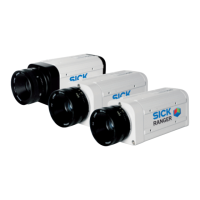Chapter 3 Reference Manual
Ranger E/D
20 ©SICK AG • Advanced Industrial Sensors • www.sick.com • All rights reserved
Mounting Rangers and Lightings
3.1 Range (3D) Measurement
The Ranger measures range by using triangulation, which means that the object is illumi-
nated with a line light from one direction, and the Ranger is measuring the object from
another direction. The most common light source used when measuring range is a line
projecting laser.
The Ranger analyzes the sensor images to locate the laser line in them. The higher up the
laser line is found for a point along the x axis (the width of the object), the higher up is that
point on the object.
Figure 3.2 – Coordinate system when measuring range.
When measuring range, there are two angles that are interesting:
The angle at which the Ranger is mounted
The angle of the incoming light (incidence)
Both angles are measured from the normal of the transport direction. The angle of the
Ranger is measured to the optical axis of the Ranger – that is, the axis through the center
of the lens.
Figure 3.3 – Angles and optical axis.
The following is important to get correct measurement results:
The laser line is aligned properly with the sensor rows in the Ranger.
The lens is focused so that the images contain a sharp laser line.
The laser is focused so that there is a sharp line on the objects, and that the laser line
covers a few rows on the sensor.
Optical axis
Incidence angle
x
(width)
z
(range)
y
(transport)

